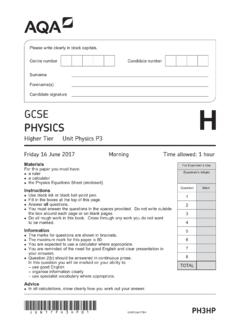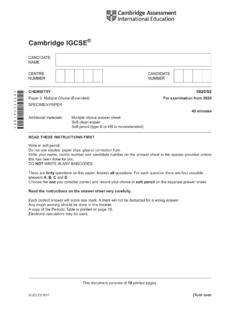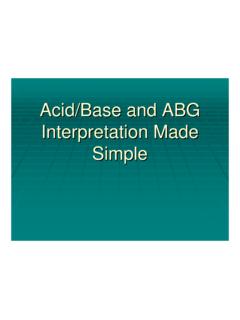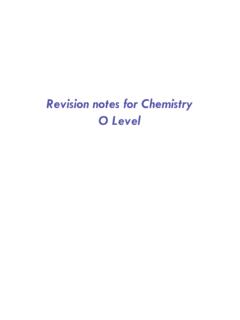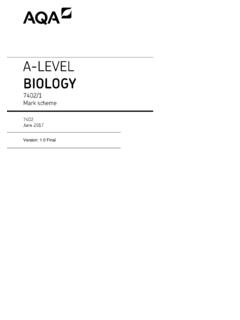Transcription of Cambridge International Examinations Cambridge ...
1 Cambridge International Examinations Cambridge International General Certificate of Secondary Education *1045436086*. CHEMISTRY 0620/31. Paper 3 (Extended) May/June 2015. 1 hour 15 minutes Candidates answer on the Question Paper. No Additional Materials are required. READ THESE INSTRUCTIONS FIRST. Write your Centre number, candidate number and name on all the work you hand in. Write in dark blue or black pen. You may use an HB pencil for any diagrams or graphs. Do not use staples, paper clips, glue or correction fluid. DO NOT WRITE IN ANY BARCODES. Answer all questions. Electronic calculators may be used. A copy of the Periodic Table is printed on page 12. You may lose marks if you do not show your working or if you do not use appropriate units. At the end of the examination, fasten all your work securely together. The number of marks is given in brackets [ ] at the end of each question or part question.
2 The syllabus is approved for use in England, Wales and Northern Ireland as a Cambridge International Level 1/Level 2 Certificate. This document consists of 12 printed pages. IB15 06_0620_31/FP. UCLES 2015 [Turn over 2. 1 (a) Coal is a solid fossil fuel. Name two other fossil fuels.. [2]. (b) Two of the elements present in a sample of coal are carbon and sulfur. A sample of coal was heated in the absence of air and the products included water, ammonia and hydrocarbons. Name three other elements present in this sample of coal.. [2]. (c) Sulfur, present in coal, is one major cause of acid rain. Sulfur burns to form sulfur dioxide which reacts with rain water to form sulfuric acid. (i) Describe how the high temperatures in vehicle engines are another cause of acid rain.. [3]. (ii) Give two harmful effects of acid rain.. [2]. (d) In 2010, a large coal-burning power station in the UK was converted to burn both coal and wood.]
3 Explain why the combustion of wood rather than coal can reduce the effect of the emissions from this power station on the level of carbon dioxide in the atmosphere.. [3]. [Total: 12]. UCLES 2015 0620/31/M/J/15. 3. 2 Iron from the Blast Furnace is impure. It contains about 5% of impurities, mainly carbon, sulfur, silicon and phosphorus, which have to be removed when this iron is converted into steel. (a) Explain how the addition of oxygen and calcium oxide removes these impurities. Include an equation for a reaction of oxygen and a word equation for a reaction of calcium oxide in this process.. [5]. (b) Mild steel is the most common form of steel. Mild steel contains a maximum of of carbon. High carbon steel contains 2% of carbon. It is less malleable and much harder than mild steel. (i) Give a use of mild steel.. [1]. (ii) Suggest a use of high carbon steel.. [1]. (iii) Explain why metals are malleable.
4 [3]. (iv) Suggest an explanation why high carbon steel is less malleable and harder than mild steel.. [2]. [Total: 12]. UCLES 2015 0620/31/M/J/15 [Turn over 4. 3 (a) The reactions between metals and acids are redox reactions. Zn + 2H+ Zn2+ + H2. (i) Which change in the above reaction is oxidation, Zn to Zn2+ or 2H+ to H2? Give a reason for your choice.. [2]. (ii) Which reactant in the above reaction is the oxidising agent? Give a reason for your choice.. [2]. (b) The rate of reaction between a metal and an acid can be investigated using the apparatus shown below. 20 40 60 80 100. gas syringe hydrochloric acid zinc foil A piece of zinc foil was added to 50 cm3 of hydrochloric acid, of concentration mol / dm3. The acid was in excess. The hydrogen evolved was collected in the gas syringe and its volume measured every minute. The results were plotted and labelled as graph 1.]
5 Graph 2 (with copper). graph 1. volume 0. 0 time The experiment was repeated to show that the reaction between zinc metal and hydrochloric acid is catalysed by copper. A small volume of aqueous copper(II) chloride was added to the acid before the zinc was added. The results of this experiment were plotted on the same grid and labelled as graph 2. UCLES 2015 0620/31/M/J/15. 5. (i) Explain why the reaction mixture in the second experiment contains copper metal. Include an equation in your explanation.. [2]. (ii) Explain how graph 2 shows that copper catalyses the reaction.. [3]. (c) If the first experiment was repeated using ethanoic acid, CH3 COOH, instead of hydrochloric acid, how and why would the graph be different from graph 1? .. [4]. (d) Calculate the maximum mass of zinc which will react with 50 cm3 of hydrochloric acid, of concentration mol / dm3. Zn + 2 HCl ZnCl 2 + H2.
6 Show your working. [3]. [Total: 16]. UCLES 2015 0620/31/M/J/15 [Turn over 6. 4 The alcohols form a homologous series. (a) (i) Give three characteristics which all members of a homologous series share.. [3]. (ii) Give the name of the third member of this series. name .. [1]. (iii) Deduce the molecular formula of the alcohol whose Mr = 158. Show your working.. [2]. (b) Explain why the following two alcohols are isomers. CH3. CH3 C OH CH3 CH2 CH2 CH2 OH. CH3.. [2]. UCLES 2015 0620/31/M/J/15. 7. (c) This question is based on typical reactions of butan-1-ol. (i) When butan-1-ol, CH3 CH2 CH2 CH2 OH, is passed over the catalyst silicon(IV) oxide, water is lost. Deduce the name and the structural formula of the organic product in this reaction. name .. structural formula [2]. (ii) Suggest the name of the ester formed from butanol and ethanoic acid.. [1]. (iii) Butan-1-ol is oxidised by acidified potassium manganate(VII).]
7 Deduce the name and the structural formula of the organic product in this reaction. name .. structural formula [2]. [Total: 13]. UCLES 2015 0620/31/M/J/15 [Turn over 8. 5 The halogens are a group of non-metals in Group VII of the Periodic Table. (a) The reactivity of the halogens decreases down the group. Describe an experiment which shows that chlorine is more reactive than iodine. Include an equation in your answer.. [3]. (b) The halogens form interhalogen compounds. These are compounds which contain two different halogens. Deduce the formula of the compound which has the composition moles of iodine atoms and moles of fluorine atoms.. [2]. (c) Iodine reacts with chlorine to form a dark brown liquid, iodine monochloride. chlorine supplied crystals of iodine I2(s) + Cl 2(g) 2 ICl (l). dark brown When more chlorine is added and the tube is sealed, a reversible reaction occurs and the reaction comes to equilibrium.]
8 ICl (l) + Cl 2(g) ICl 3(s). dark brown yellow (i) Give another example of a reversible reaction.. [1]. (ii) Explain the term equilibrium.. [2]. UCLES 2015 0620/31/M/J/15. 9. (d) Chlorine is removed from the tube and a new equilibrium is formed. Explain why there is less of the yellow solid and more dark brown liquid in the new equilibrium mixture.. [2]. (e) A sealed tube containing the equilibrium mixture is placed in ice-cold water. There is an increase in the amount of yellow solid in the equilibrium mixture. What can you deduce about the forward reaction in this equilibrium? ICl (l) + Cl 2(g) ICl 3(s). Explain your deduction.. [3]. [Total: 13]. UCLES 2015 0620/31/M/J/15 [Turn over 10. 6 Acid-base reactions are examples of proton transfer . (a) Ethylamine is a weak base and sodium hydroxide is a strong base. (i) In terms of proton transfer , explain what is meant by the term weak base.]
9 [2]. (ii) Given aqueous solutions of both bases, describe how you could show that sodium hydroxide is the stronger base. How could you ensure a fair' comparison between the two solutions? .. [3]. (b) Ethylamine reacts with acids to form salts. CH3CH2NH2 + HCl CH3CH2NH3Cl ethylammonium chloride (i) Complete the equation for the reaction between sulfuric acid and ethylamine. Name the salt formed..CH3CH2NH2 + .. name of salt .. [3]. (ii) Amines and their salts have similar chemical properties to ammonia and ammonium salts. Suggest a reagent that could be used to displace the weak base, ethylamine, from its salt ethylammonium chloride.. [1]. UCLES 2015 0620/31/M/J/15. 11. (c) Gases diffuse, which means that they move to occupy the total available volume. (i) Explain, using kinetic particle theory, why gases diffuse.. [2]. (ii) When the colourless gases hydrogen bromide and ethylamine come into contact, a white solid is formed.
10 CH3CH2NH2(g) + HBr(g) CH3CH2NH3Br(s). white solid The following apparatus can be used to compare the rates of diffusion of the two gases ethylamine and hydrogen bromide. gives off gives off CH3CH2NH2(g) HBr(g). A B C. cotton wool soaked in cotton wool soaked in ethylamine(aq) conc. hydrobromic acid Predict at which position, A, B or C, the white solid will form. Explain your choice.. [3]. [Total: 14]. UCLES 2015 0620/31/M/J/15 [Turn over UCLES 2015. DATA SHEET. The Periodic Table of the Elements the live examination series. Group I II III IV V VI VII 0. 1 4. H He Hydrogen Helium 1 2. 7 9 11 12 14 16 19 20. Li Be B C N O F Ne Lithium Beryllium Boron Carbon Nitrogen Oxygen Fluorine Neon 3 4 5 6 7 8 9 10. 23 24 27 28 31 32 40. Na Mg Al Si P S Cl Ar Sodium Magnesium Aluminium Silicon Phosphorus Sulfur Chlorine Argon 11 12 13 14 15 16 17 18. 39 40 45 48 51 52 55 56 59 59 64 65 70 73 75 79 80 84.]

